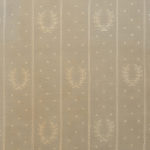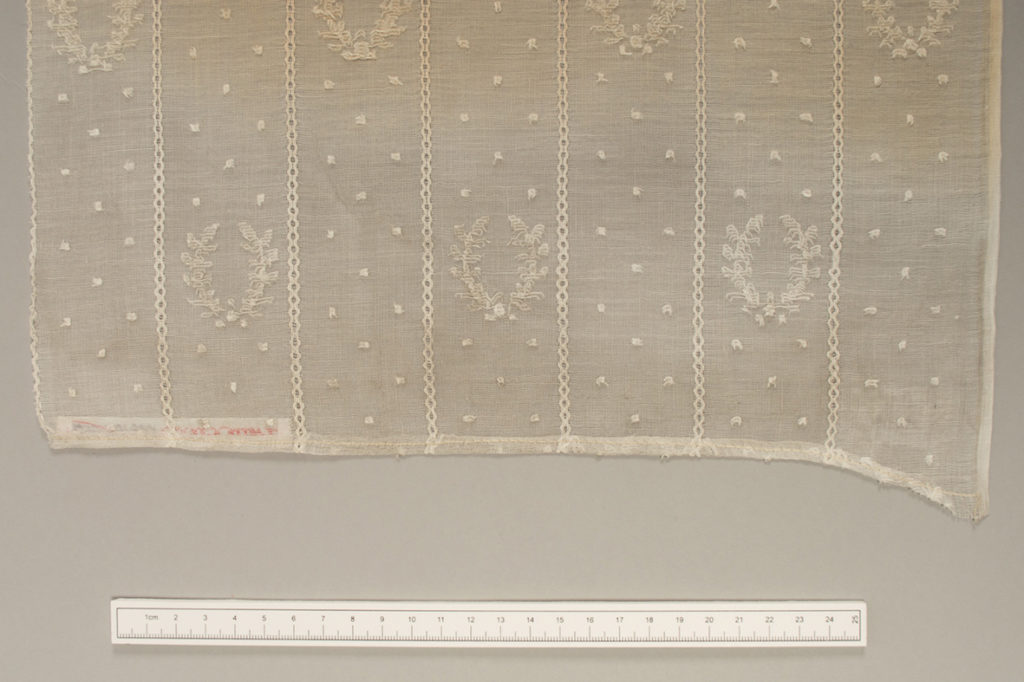
By Erinn Dunlea, first year student, MPhil Textile Conservation.
Conservators must tailor each conservation treatment to the needs of the object in their care. This can be informed by the object’s nature, condition, and the context and objectives of the treatment.
This past semester I undertook the conservation of a length of fabric which belongs to the collection of Glasgow Museums. It is one of a group of five similar objects and is the fourth to be treated by students on the programme. A past student has detailed a previous treatment in another blog post. The fabric is an off-white, fine, open-weave cotton. Supplementary warps and wefts divide the fabric into columns and create textured, repeating motifs of wreaths and dots. Before I undertook the treatment the object was heavily soiled with dark sooty particulate soiling, particularly on the front, giving it a dull, grey appearance. There was significant differential yellowing concentrated in the centre, caused by the acidic degradation products of the cotton fibres. The textile was also quite brittle and stiff which contributed to its physical fragility. The treatment aimed to clean and stabilise the object.
After documenting the object, I undertook surface cleaning using low-powered vacuum suction, Vellux® blanket fabric, and cosmetic sponges to remove as much of the sooty soiling as possible prior to wet cleaning. A large amount of soiling was removed and there was a clear visual improvement, however some dark soiling remained embedded in the yarns.

I planned to wet clean the object to reduce the yellow discolouration. The thick supplementary warps had created vulnerabilities throughout the object where the fine wefts were under greater tension and were extremely fragile. This meant that the approach to the wet cleaning treatment had to be modified to minimise any risk of damage. Rather than submerge the object in a predetermined volume of liquid, solutions were added slowly as a series of ‘puddles.’ These puddles achieved the necessary depth to submerge the textile but were shallow enough to prevent suspension and minimise uncontrolled movement. Initially the object was wetted out with tap water to liberate any soiling and degradation products that would be readily water-soluble. Dark yellow soiling was immediately seen to enter the bath along with grey streaks, likely to be sooty soiling. A sample was drawn from this initial soak and the pH was recorded at 5.3 using a pH meter, confirming the presence of acidic products. There were areas of the object close to the hems which were slow to wet out. These areas had exhibited heavy sooty soiling, and this reluctance to wet out could be attributed to the oily, tarry component often present in soot.[1] The wash solution contained a conservation-grade detergent at a high concentration to facilitate soil removal with as little agitation as possible and included a buffer solution to counteract the effects of the acidic degradation products released into the wash-bath. To reduce movement of the object while cleaning, a sponge roller was used, and this was passed across the textile applying minimal pressure. This gently encouraged interaction between the wash solution and the object without creating large amounts of foam.

Tap water was used to wet out the object at the beginning of the wet-cleaning process © CSG CIC Glasgow Museums Collection and University of Glasgow, 2021 
A roller was then passed over the object to encourage interaction between the puddle of solution and the textile © CSG CIC Glasgow Museums Collection and University of Glasgow, 2021
Samples were drawn from each bath to assess the level of soil removal and the amount of soiling released was quite astonishing. After it was determined that no more soiling was being released into the wash-bath, the object was gently rinsed of all detergent solution. The object was dried within the wash-bath to limit movement. Blotting paper was pressed onto the surface to remove water and this also drew out further grey soiling in places, particularly from the thick supplementary yarns, and the hems.
Overall, the treatment was successful in its aim to improve the stability of the object through the removal of large amounts of harmful soiling. This had the additional benefit of improving the object’s visual appearance by reducing discoloration and enhancing uniformity. The flexibility and handle of the object was improved, and the creases were reduced by the wet-cleaning process. After wet-cleaning, the object was given stitched support in vulnerable areas using materials that were dyed to match in order to be visually unobtrusive and maintain the object’s translucency. This was the first complete conservation treatment I have undertaken, and it presented a real challenge and an excellent opportunity for me to apply the knowledge and skills I have gained thus far.
Reference
[1] Meller, Nora. A Preliminary Investigation into the Characterisation of Sooty Soilings on Historic Textiles. Glasgow: University of Glasgow, 2017.





What a difference you have made! Well done on your first full treatment.
Always lovely to hear from the TCC, please give my best wishes to everyone, I was was your fFund Raiser at Hampton Court! Hope to see you all if there can be an Open Day.
Sorry I mean I was your First Company Secretary but I did fund raise as well. DAWN M